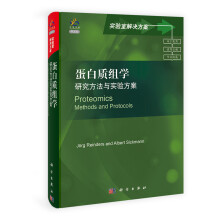蛋白质组学:研究方法与实验方案

目 录内容简介
目录前言 v撰稿人 ix第一部分 引言1. 蛋白质组学简介 3Friedrich Lottspeich第二部分 电泳分离2. 高分辨率二维电泳 13Walter Weiss and Angelika Gorg3. 非经典二维电泳 33JacquelineBurre,Ilka Wittig,and Hermann Schagger4. 蛋白质检测与定量技术用于基于凝胶的蛋白质组学分析 59Walter Weiss,Florian Weiland,and Angelika Gorg第三部分 质谱和串联质谱的应用5. 基质辅助激光解吸电离质谱 85Rainer Cramer6. 毛细管电泳质谱联用应用于人尿液蛋白质组学分析与生物标志物发现 105PetraZurbig,Eric Schiffer,and Harald Mischak7. 多肽纳升级液相色谱指南 123Thomas Frohlich and Georg J.Arnold8. 多维蛋白鉴定技术 143Katharina Lohrig and Dirk Wolters9. 肽段为中心的蛋白质组学技术分析血小板蛋白 155Oliver Simon,Stefanie Wortelkamp,and Albert Sickmann10. 高分辨率质谱蛋白质组分析技术鉴定小鼠小肠20S蛋白质组分子组成 173Reinhold Weber,Regina Preywisch,Nikolay Youhnovski,Marcus Groettrup,and Michael Przybylski第四部分 蛋白质组学定量技术11. 基于液相色谱质谱联用的定量蛋白质组学 189Michael W.Linscheid,Robert Ahrends,Stefan Pieper,and Andreas Kuhn12. 胶内酶切同位素标记蛋白质技术用于相对定量 207Carla Schmidt and Henning Urlaub13.电喷雾质谱技术用于血浆蛋白质组定量分析 227Hong Wang and Sam Hanash第五部分 质谱数据解读14. 算法和数据库 245Lennart Martens and Rolf Apweiler15. 鸟枪法蛋白质鉴定和质谱法蛋白质定量 261Bingwen Lu,Tao Xu,Sung Kyu Park,and John R.Yates III第六部分 蛋白质修饰分析16. 脑蛋白氧化修饰蛋白质组学鉴定 291Rukhsana Sultana,Marz ia Perluigi,and D.Allan Butter field17.同位素标记、磷酸化多肽亲和富集技术用于液相色谱-串联质谱蛋白质组分析 303Uma Kota,Ko-yi Chien,and Michael B.Goshe第七部分 亚细胞蛋白质组学18. 细胞器蛋白质组学:天然蛋白胶内酶切筛选减少样本的复杂性 325Veronika Reisinger and Lutz A.Eichacker19. 聚合物双水相系统逆流分配法分离神经系统质膜 335Jens Schindler and Hans Gerd NothWang20. 液相色谱串联质谱技术进行拟南芥蛋白质组分析的质膜蛋白富集和制备 341Srijeet K.Mitra,Steven D.Clouse,and Michael B.Goshe第八部分 蛋白质相互作用分析21.Strep/FLAG(SF)-串联亲和纯化标签用于哺乳动物细胞蛋白质复合物串联亲和纯化 359Christian Johannes Gloeckner,Karsten Boldt,Annette Schumacher,and Marius Ueffing22. 顺序多肽亲和纯化系统分离和鉴定大肠杆菌蛋白质复合物 373Mohan Babu,Gareth Butland,Oxana Pogoutse,Joyce Li,Jack F.Greenblatt,and AndreWEmili23. 生物信息学方法分析蛋白质相互作用 401Beate Kruger and Thomas Dandekar索引 433(宋凯 张春秀 译)ContentsPreface. vContributors. ixPART I INTRODUCTION1. Introduction to Proteomics 3Friedrich LottspeichPART II ELECTROPHORETIC SEPARATIONS2. High-Resolution Two-Dimensional Electrophoresis 13Walter Weiss and Angelika Gorg3. Non-classical 2-D Electrophoresis 33Jacqueline Burre,Ilka Wittig,and Hermann Sch?gger4. Protein Detection and Quantitation Technologies for Gel-Based Proteome Analysis 59Walter Weiss,Florian Weiland,and Angelika GorgPART III MASS SPECTROMETRY AND TANDEM MASS SPECTROMETRY APPLICATIONS5. MALDI MS 85Rainer Cramer6. Capillary Electrophoresis Coupled to Mass Spectrometry for Proteomic Profiling of Human Urine and Biomarker Discovery 105Petra Zurbig,Eric Schiffer,and Harald Mischak7. A Newcomer’s Guide to Nano-Liquid-Chromatography of Peptides 123Thomas Frohlich and Georg J. Arnold8. Multidimensional Protein Identification Technology 143Katharina Lohrig and Dirk Wolters9. Characterization of Platelet Proteins Using Peptide Centric Proteomics 155Oliver Simon,Stefanie Wortelkamp,and Albert Sickmann10. Identification of the Molecular Composition of the 20S Proteasome of Mouse Intestine by High-Resolution Mass Spectrometric Proteome Analysis 173Reinhold Weber,Regina Preywisch,Nikolay Youhnovski,Marcus Groettrup,and Michael PrzybylskiPART IV QUANTITATIVE PROTEOMICS11. Liquid Chromatography-Mass Spectrometry-Based Quantitative Proteomics. 189Michael W. Linscheid,Robert Ahrends,Stefan Pieper,and Andreas Kuhn12. iTRAQ-Labeling of In-Gel Digested Proteins for Relative Quantification 207Carla Schmidt and Henning Urlaub13. Electrospray Mass Spectrometry for Quantitative Plasma Proteome Analysis 227Hong Wang and Sam HanashPART V INTERPRETATION OF MASS SPECTROMETRY DATA14. Algorithms and Databases 245Lennart Martens and Rolf Apweiler15. Shotgun Protein Identification and Quantification by Mass Spectrometry 261Bingwen Lu,Tao Xu,Sung Kyu Park,and John R. Yates IIIPART VI ANALYSIS OF PROTEIN MODIFICATIONS16. Proteomics Identification of Oxidatively Modified Proteins in Brain 291Rukhsana Sultana,Marzia Perluigi,and D. Allan Butterfield17. Isotope-Labeling and Affinity Enrichment of Phosphopeptides for Proteomic Analysis Using Liquid Chromatography-Tandem Mass Spectrometry 303Uma Kota,Ko-yi Chien,and Michael B. GoshePART VII SUBCELLULAR PROTEOMICS18. Organelle Proteomics:Reduction of Sample Complexity by Enzymatic In-Gel Selection of Native Proteins 325Veronika Reisinger and Lutz A. Eichacker19. Isolation of Plasma Membranes from the Nervous System by Countercurrent Distribution in Aqueous Polymer Two-Phase Systems 335Jens Schindler and Hans Gerd Nothwang20. Enrichment and Preparation of Plasma Membrane Proteins from Arabidopsis thaliana for Global Proteomic Analysis Using Liquid Chromatography-Tandem Mass Spectrometry 341Srijeet K. Mitra,Steven D
目 录内容简介
自“蛋白质组学”的概念发展以来,研究者对细胞网络的深入了解获得重要进展,但是蛋白质的丰度、动态性和相互作用等巨大的研究范围提出了更深入的挑战。本《蛋白质组学:研究方法与实验方案》,蛋白质组学研究领域的专家提供了详细的技术,概述了蛋白质组学不同领域的挑战和机会,以及成功的蛋白质组学分析实例的尖端方法。《蛋白质组学:研究方法与实验方案》秉承Springer《分子生物学方法》系列丛书的一贯风格,阐述明晰、便于使用,各章包括,必备材料与试剂的清单,易于操作的实验室方案、疑难问题的注意事项和易犯失误的避免。
比价列表







 缺书网
缺书网 扫码进群
扫码进群